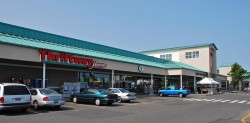 Access to adequate food and a nutritious diet are essential pre-requisites for basic health and well-being. At a neighborhood level, one of the primary factors influencing people’s access to food is the availability of full-service grocery stores. Access to farmer’s markets, produce stands, and community gardens can also play an important role. Conversely, neighborhoods that are dominated by plentiful sources of unhealthy food, such as fast food restaurants and convenience stores, can make it more difficult for residents to maintain a healthy diet. For low-income residents, access to sufficient food is also shaped by the locations of supplemental food sources such as food pantries and food retailers that accept SNAP (food
Access to adequate food and a nutritious diet are essential pre-requisites for basic health and well-being. At a neighborhood level, one of the primary factors influencing people’s access to food is the availability of full-service grocery stores. Access to farmer’s markets, produce stands, and community gardens can also play an important role. Conversely, neighborhoods that are dominated by plentiful sources of unhealthy food, such as fast food restaurants and convenience stores, can make it more difficult for residents to maintain a healthy diet. For low-income residents, access to sufficient food is also shaped by the locations of supplemental food sources such as food pantries and food retailers that accept SNAP (food  stamps).
stamps).
The Food Map Series examines the distribution of typical sources of healthy and unhealthy food, as well as the locations of supplemental food sources for low-income residents. The maps also explore how these distributions relate to demographic patterns, highlighting key locations across the region with potential racial and income disparities in access to food.
|
Map Series: |
Photo credits, top to bottom: By http://www.flickr.com/photos/calliope (http://www.flickr.com/photos/calliope/4206360542) [CC-BY-2.0 (http://creativecommons.org/licenses/by/2.0)], via Wikimedia Commons;
Original image URL: http://www.flickr.com/photos/coreytempleton/3578436615/Title: Deering Oaks Farmers Market;
By Steve Morgan (Own work) [CC-BY-SA-3.0 (http://creativecommons.org/licenses/by-sa/3.0) or GFDL (http://www.gnu.org/copyleft/fdl.html)], via Wikimedia Commons

